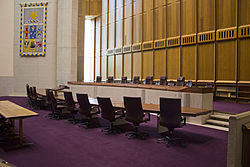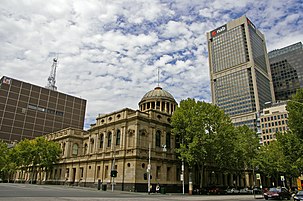Judiciary of Australia
| This article is part of a series on the |
| Politics of Australia |
|---|
 |
| Constitution |
|
|
The judiciary of Australia comprises judges who sit in federal courts and courts of the States and Territories of Australia. The High Court of Australia sits at the apex of the Australian court hierarchy as the ultimate court of appeal on matters of both federal and State law.
The large number of courts in Australia have different procedural powers and characteristics, different jurisdictional limits, different remedial powers and different cost structures.
Under the Australian Constitution, federal judicial power is vested in the High Court of Australia and such other federal courts as may be created by the federal Parliament. These courts include the Federal Court of Australia, the Federal Circuit Court of Australia, and the Family Court of Australia. Federal jurisdiction can also be vested in State courts.
The supreme courts of the states and territories are superior courts of record with general and unlimited jurisdiction within their own state or territory. They can try any justiciable dispute, whether it be for money or not, and whether it be for $1 or $1 billion.
Like the supreme courts, the Family Court and Federal Court are superior courts of record, which means that they have certain inherent procedural and contempt powers. But unlike their supreme court counterparts, their subject matter jurisdiction must be granted by statute. Under the doctrine of "accrued jurisdiction", the Federal Court can, however, rule on issues outside its explicit jurisdiction, provided that they are part of a larger matter that the court does have jurisdiction over.[1]
The High Court has limited trial powers, but very rarely exercises them. It has ample power to transfer cases started there to another, more appropriate court, so that the High Court can conserve its energies for its appellate functions.
Common law and equity are administered by the same courts, in a manner similar to that of the Judicature Acts in the United Kingdom. Legal and equitable remedies may be pursued in the one action in the one court.
Judges
Judges are appointed by the executive government, without intervention by the existing judiciary.[2] Once appointed, judges have tenure and there are restrictions on their removal from office. For example, a federal judge may not be removed from office except by the Governor-General upon an address of both Houses of Parliament for proved misbehaviour.[3] Judges in Australia are appointed by the Executive government of the relevant jurisdiction, and most judges have previously practised as a barrister. Federal judges may only serve until age 70.[3] There is no constitutional limit on the length of service of State court judges, but State laws usually fix a retirement age. For example, in New South Wales, judges must retire at age 72,[4] though they can remain as "acting judges" until age 76.[5]
Australian court hierarchy
| General federal law | Family law | Employment law | General state/territory law | |
|---|---|---|---|---|
| Apex court | High Court of Australia | |||
| Superior courts (appellate jurisdiction) | Full Court of the Federal Court of Australia | Full Court of the Family Court of Australia | Federal Fair Work Division of the Full Court of the Federal Court of Australia State/territory Various |
All matters Court of Appeal (ACT - Qld - Vic - WA); Full Court of the Federal Court of Australia (NI) Civil matters |
| Superior courts (trial jurisdiction) | Federal Court of Australia | Family Court (WA - Rest of Australia) | Federal/Victoria/Territories Fair Work Division of the Federal Court of Australia Other states Various |
Supreme Court (ACT - NI - NSW - NT - Qld - SA - Tas - Vic - WA) |
| Intermediate courts | Federal Circuit Court of Australia (does not hear WA family law matters) | Federal/Victoria/Territories Fair Work Division of the Federal Circuit Court of Australia Other states Industrial Court (Qld); Employment Court (SA) Supreme Court (NSW) |
District Court (NSW - Qld - SA - WA); County Court (Vic) No intermediate court (ACT - NI - NT - Tas) | |
| Inferior courts | Magistrates' Court (ACT - Qld - SA - Tas - Vic - WA); | |||
| Quasi-judicial tribunals for e.g. small claims and/or administrative review | Administrative review Administrative Appeals Tribunal Other tribunals |
Child support Social Services and Child Support Division of the Administrative Appeals Tribunal |
Federal/Victoria/Territories Fair Work Commission Other states Industrial Relations Commission (NSW - Qld - WA); Employment Tribunal (SA) |
Administrative review and/or small claims ACAT (ACT) - NCAT (NSW) - NTCAT (NT) - QCAT (Qld) - VCAT (Vic) - SACAT (SA) - Various (Tas) - SAT (WA) Minor claims division in Magistrates Court (SA - Tas - WA) |
| Australian court hierarchy |
|---|
 |
| Federal Law Courts |
| Courts of Australian States and Territories |
The hierarchy consists of a variety of courts and tribunals at both the federal and state and territory levels, with the High Court being the highest court in the Australian judicial system.[6] A single body[7] of Australian common law is applied in the various Australian courts, and ultimately determined by the High Court now that appeals to the (British) Judicial Committee of the Privy Council have been abolished.[8][9][10]
Superior and inferior courts
The High Court has described the concept of a superior court (and associated 'notions derived from the position of pre-Judicature common law courts') as having 'no ready application in Australia to federal courts.'[11] Despite this, Australian courts are frequently characterised as either 'superior' or 'inferior.' The Federal Court[12] and the supreme courts of each state and territory are generally considered to be superior courts.
There is no single definition of the term 'superior court' (or 'superior court of record'). In many respects Australian superior courts are similar to the Senior Courts of England and Wales. In Australia, superior courts generally:
- have unlimited jurisdiction in law and equity,[13] or at least are not subject to jurisdictional limits as to the remedies they may grant;
- determine appeals, at least as part of their jurisdiction;
- are composed of judges whose individual decisions are not subject to judicial review[14] or appeal to a single judge;
- are composed of judges entitled to the style and title The Honourable Justice; and
- regularly publish their decisions in written form.
Inferior courts are those beneath superior courts in the appellate hierarchy, and are generally seen to include the magistrates' and district (or county) court of each state as well as the Federal Circuit Court. Inferior courts are typically characterised by:
- jurisdiction conferred by statute and limited as to subject matter or the quantum of relief; and
- amenability to judicial review by a single judge of a superior court where a right of appeal is not available.
Federal courts
These courts among them have jurisdiction over Commonwealth law, that is, law made by the Federal parliament of Australia.
High Court of Australia

The High Court is the highest court in Australia. It was created by section 71 of the Constitution.[15] It has appellate jurisdiction over all other courts. It also has some original jurisdiction, and has the power of constitutional review. The High Court of Australia is the superior court to all federal courts, and is also the final route of appeal from all state superior courts.[16]
Appeals to the High Court are by special leave only, which is rarely granted. Therefore, for most cases, the appellate divisions of the Supreme Courts of each state and territory and the Federal Court are the ultimate appellate courts. The Full Court of the High Court is the ultimate appeal court for Australia.
Appeals from Australian courts to the Privy Council were initially possible, however the Privy Council (Limitation of Appeals) Act 1968 closed off all appeals to the Privy Council in matters involving federal legislation,[8] and the Privy Council (Appeals from the High Court) Act 1975 closed almost all routes of appeal from the High Court.[9] The Australia Act 1986 eliminated appeals from state Supreme Courts to the Privy Council.[17] Appeals from the High Court to the Privy Council are now only theoretically possible in inter se matters with leave of the High Court under section 74 of the Constitution; however, the High Court has indicated it will not grant such leave in the future.[10]
Federal Court of Australia

The Federal Court primarily hears matters relating to corporations, trade practices, industrial relations, bankruptcy, customs, immigration and other areas of federal law.[1] The court has original jurisdiction in these areas, and also has the power to hear appeals from a number of tribunals and other bodies (and, in cases not involving family law, from the Federal Circuit Court of Australia.)[18]
The court is a superior court of limited jurisdiction, but below the High Court of Australia in the hierarchy of federal courts, and was created by the Federal Court of Australia Act in 1976.[19]
Decisions of the High Court are binding on the Federal Court. There is an appeal level of the Federal Court (the "Full Court" of the Federal Court), which consists of several judges, usually three but occasionally five in very significant cases.[20]
Family Court of Australia
The Family Court has jurisdiction over family law matters. It is a superior court of limited jurisdiction and was established in 1975 by the Family Law Act 1975 by the federal parliament. The Commonwealth has power over marriage and divorce under the Constitution. In the 1990s the states referred many of their powers over children of non-married couples to the Commonwealth, which added this power to the Family Court.
Uniquely among the states, Western Australia took up the option of establishing its own Family Court in 1975, and in that state all jurisdiction under the Family Law Act 1975 is exercised by the Family Court of Western Australia and not the Family Court of Australia.
The Family Court is a specialist family law court, involving parental disputes, matrimonial property, child support and other family-related laws. The principles of stare decisis (binding law from higher courts) are the same as for the Federal Court. Appeals from the Family Court are heard by the "Full Court" of the Family Court (three to five judges). Appeals from the Full Court lie to the High Court of Australia, though special leave is required. A single judge of the Family Court may hear appeals in family law matters from the Federal Circuit Court of Australia. Appeals from the Federal Circuit Court must go to either of these courts (Federal Court or Family Court), dependent on the area of law.
Decisions of the Full Court of the Federal and Family Courts are binding on Federal Circuit Court judges, as are decisions of these courts on appeal from a Federal Circuit Court judge. In other circumstances, decisions of a single Federal or Family Court judge are not strictly binding; however, these will usually be followed by sentencing.
Federal Circuit Court of Australia
The Federal Circuit Court of Australia (formerly known as the Federal Magistrates Court of Australia)[21] is an Australian court with jurisdiction over matters broadly relating to family law and child support, administrative law, admiralty law, bankruptcy, copyright, human rights, industrial law, migration, privacy and trade practices. There has been a shift recently towards having most cases held in this court, thereby freeing up workload so the Federal Court of Australia and the Family Court of Australia can hear more complicated cases. This court also hears appeals from various federal tribunals.
State and territory courts and tribunals

Each state and territory has a court hierarchy of its own, with the jurisdictions of each court varying from state to state and territory to territory. However, all states and territories have a supreme court, which is a superior court of record and is the highest court within that state or territory. These courts also have appeal divisions, known as the Full Court or Court of Appeal of the Supreme Court (in civil matters), or the Court of Criminal Appeal (in criminal matters.)
Decisions of the High Court are binding on all Australian courts, including state and territory supreme courts.
The state and territory courts can sometimes exercise federal jurisdiction (i.e. rule on matters subject to federal legislation.) However, an attempt by the states and the Commonwealth to pass legislation that would cross-vest state judicial powers in the federal courts was struck down by the High Court in Re Wakim; Ex parte McNally,[22] as being unconstitutional. Notwithstanding this failure, however, both state and federal courts can exercise an "accrued jurisdiction," which enables them to hear all legal issues arising from a single set of facts. This enables all courts to deal with virtually all issues arising from the facts of a case, provided that the particular court has jurisdiction to hear the principal cause of action.
Most of the states have two further levels of courts, which are comparable across the country. The district court (or county court in Victoria) handles most criminal trials for less serious indictable offences, and most civil matters below a threshold (usually around $1 million). The magistrates' court (or local court) handles summary matters and smaller civil matters. In jurisdictions without district or county courts, most of those matters are dealt with by the supreme courts. In Tasmania and the two mainland territories, however, there is only a Magistrates Court below the Supreme Court.
In the three external territories (that is, territories not directly forming part of the Commonwealth of Australia but administered by the Commonwealth) there is a supreme court and a magistrates' court or court of petty sessions. The supreme courts are staffed by judges of other courts, usually the Federal Court. Appeals from those courts lie to the full Federal Court. As these territories have very small populations, the courts only sit from time to time as needed. The three external territories are Norfolk Island, Christmas Island and Cocos (Keeling) Islands.
The remaining external territories (including Antarctica) do not have permanent courts. In the event of a case arising from these territories, the courts of the ACT have jurisdiction.
All the states and territories, with the exception of Tasmania, have a civil and administrative tribunal. These hear cases relating to lesser State or Territory administrative disputes (involving some individual, business or government body). These commonly involve actions by persons bound to act pursuant to some form of devolved legislation; such as Environmental Regulations or Rental Tenancy Regulations.
A table of the court hierarchy and civil and administrative tribunals of the Australian states and territories follows here:
New South Wales |
Victoria |
Queensland |
South Australia |
Western Australia |
Tasmania |
Northern Territory |
Australian Capital Territory |
Norfolk Island |
See also
- Drug courts in Australia
- Law enforcement in Australia
- List of Commonwealth courts and tribunals
- Victoria Bar Association
References
- ^ a b Justice James Allsop. "An Introduction to the Jurisdiction of the Federal Court of Australia". [2007] Federal Judicial Scholarship 15.
- ^ Attorney-General (NSW) v Quin [1990] HCA 21, (1990) 170 CLR 1 at 33.
- ^ a b Constitution (Cth) s 72.
- ^ Judicial Officers Act 1986 (NSW) s 44.
- ^ Supreme Court Act 1970 (NSW) s 37.
- ^ Australian Bureau of Statistics, 1301.0 – Year Book Australia, 2012, Courts.
- ^ Kirk v Industrial Court of NSW [2010] HCA 1, (2010) 239 CLR 531 at [99].
- ^ a b Privy Council (Limitation of Appeals) Act 1968 (Cth).
- ^ a b Privy Council (Appeals from the High Court) Act 1975 (Cth).
- ^ a b Although Gibbs CJ, Mason, Wilson and Dawson JJ referred to the 'theoretical possibility' of an appeal to the Privy Council under the Constitution (Cth) s 74 in Attorney-General v Finch [1984] HCA 40, (1984) 155 CLR 107, the following year Court described the grant of a s 74 certificate as 'impossible' in Kirmani v Captain Cook Cruises Pty Ltd (No 2) [1985] HCA 27, (1985) 159 CLR 461.
- ^ Re McJannet; Ex Parte Minister for Employment Training & Industrial Relations (Qld) [1995] HCA 31, (1995) 184 CLR 620 at p. 653 (Toohey, McHugh and Gummow JJ).
- ^ Federal Court of Australia Act 1976 (Cth) s 5.
- ^ See for example Supreme Court Act 1970 (NSW) s 23; Constitution of Queensland 2001 (Qld) s 58; Supreme Court Act 1935 (SA) s 17; Constitution Act 1975 (Vic) s 85; Supreme Court Act 1935 (WA) s 16.
- ^ Although designation as a 'superior court of record' does not necessarily exclude the possibility of judicial review: Kirk v Industrial Court of NSW [2010] HCA 1, (2010) 239 CLR 531 at [107].
- ^ Constitution (Cth) s 71.
- ^ Constitution (Cth) s 73.
- ^ Australia Act 1986 (Imp) and Australia Act 1986 (Cth).
- ^ Federal Court of Australia Act 1976 (Cth) s 24.
- ^ Federal Court of Australia Act 1976 (Cth).
- ^ Federal Court of Australia Act 1976 (Cth) s 14.
- ^ Federal Circuit Court of Australia Act (Cth) s 8.
- ^ Re Wakim; Ex parte McNally [1999] HCA 27, (1999) 27 CLR 511.
